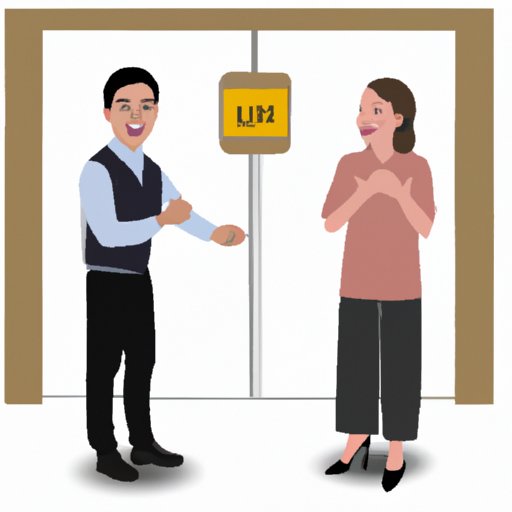
Introduction
Job interviews can be nerve-wracking experiences, but making a strong first impression can set you up for success. Your introduction is the first chance you have to make an impression on the interviewer, so it’s important to get it right. In this article, we’ll explore 10 tips for making a great first impression, common mistakes to avoid, and creative strategies for introducing yourself. By the end, you’ll be equipped with the tools and knowledge you need to confidently introduce yourself during your next interview.

10 Tips for Making a Great First Impression in Your Next Job Interview
Introducing yourself in a job interview may seem straightforward, but there are certain details you should be aware of. To make a great first impression, keep these tips in mind:
- Be confident and engaging when you introduce yourself. Smile and make eye contact with the interviewer.
- Provide your name and a brief summary of your background and qualifications. Keep it concise and relevant to the job you’re interviewing for.
- If you have a specific reason for applying to this company or position, mention it briefly in your introduction.
- Prepare your introduction ahead of time so you’re not caught off guard. Practice with a friend or in front of a mirror.
- Pay attention to your body language. Stand or sit up straight, and avoid fidgeting or crossing your arms. Project confidence and enthusiasm.
- Be respectful and courteous to everyone you meet during the interview process, from receptionists to hiring managers.
- Avoid using filler words such as “um” or “like” in your introduction.
- If you have any relevant accomplishments or awards, mention them briefly in your introduction.
- Be mindful of your tone and demeanor. You want to come across as friendly and approachable, but also professional and competent.
- End your introduction with an invitation for the interviewer to ask any questions or for you to elaborate on any points.
5 Common Mistakes to Avoid When Introducing Yourself in a Job Interview
While it’s important to know what to do when introducing yourself, it’s equally important to avoid common mistakes that can detract from your first impression. Here are five pitfalls to avoid:
- Don’t use inappropriate language or make off-color remarks.
- Don’t recite your entire work history or go into too much detail about your personal life.
- Avoid rambling or using filler words such as “um” or “like.”
- Don’t speak negatively about your former employers or colleagues.
- Don’t be overly boastful or arrogant in your introduction. Focus on your skills and qualifications, but be humble and respectful.
Crafting an Elevator Pitch for Your Next Interview
One effective way to introduce yourself in an interview is to create an elevator pitch. This is a brief, persuasive speech that outlines who you are, what you do, and why you’re the best candidate for the job. Here’s how to create an elevator pitch:
- Start with a punchy hook that grabs the interviewer’s attention. For example, “As a seasoned marketing professional with a passion for storytelling…”
- Gently introduce yourself by name and provide context for your experience. For example, “my name is John and I have over 10 years of experience in content marketing for software companies.”
- Highlight your unique skills or value proposition. Explain how your experience or background sets you apart from other candidates. For example, “I’m particularly skilled in crafting engaging social media campaigns that drive conversions.”
- Provide examples of your work or accomplishments. Demonstrate how your abilities have resulted in real-world success. For example, “I led a campaign last year that resulted in a 50% increase in e-book downloads.”
- Close with a call-to-action or question that demonstrates your enthusiasm for the position. For example, “I’m excited about the opportunity to apply my skills to your open marketing position. How can I best showcase my abilities during this interview?”
The Power of Storytelling in Job Interviews: How to Use Narrative to Introduce Yourself
One way to make your introduction memorable and unique is to frame it as a story. People are naturally drawn to stories, and they can be an effective way to convey your skills and experiences in a relatable way. Here’s how to use storytelling to introduce yourself:
- Choose a compelling narrative that highlights your skills or background. For example, you might tell the story of how you discovered your passion for graphic design, or how you overcame a major challenge at work.
- Structure your story with a clear beginning, middle, and end. Make sure it flows logically and provides enough detail to be interesting, but not enough to be overwhelming.
- Focus on the key skills or takeaways you want the interviewer to remember. For example, if your story is about how you overcame a challenge, emphasize your problem-solving skills and ability to think outside the box.
- Practice your story ahead of time and make sure you can deliver it smoothly and confidently. Don’t go off on tangents or get lost in the details. Keep it concise and focused.
- End your story with a clear tie-in to the job or company you’re interviewing with. Explain how your skills and experiences can benefit the company and why you’re excited about the opportunity to work there.
Introducing Yourself with Confidence: Tips from Professional Interview Coaches
If you’re struggling with nerves or confidence when introducing yourself, don’t worry. Many job seekers struggle with this aspect of the interview process. Here are some tips from professional interview coaches:
- Practice active listening. Listen closely to the interviewer’s questions and make sure you understand what they’re asking before you respond.
- Avoid speaking too quickly or too softly. Pace yourself and project your voice so you’re easily heard.
- Focus on your breathing. Take deep breaths before and during your introduction to calm your nerves.
- Visualize success. Picture yourself delivering a confident, engaging introduction and succeeding in the interview process.
- Remember that everyone gets nervous in interviews. Don’t beat yourself up if you stumble over your words or forget a point. Just take a deep breath and continue.
Beyond the Basics: Creative Ways to Introduce Yourself in an Interview
While the traditional introduction methods we’ve discussed can be effective, some job seekers may want to try more unconventional approaches. Here are some creative ways to introduce yourself:
- Use humor to make a memorable impression. For example, you might say “I’m not just an Excel wizard, I’m also a champion cupcake baker.”
- Bring a prop or visual aid to illustrate your skills. For example, you might bring in a portfolio of your design work or a project that you’ve completed.
- Frame your introduction as a problem-solving exercise. For example, you might say “My name is Sarah, and I’m here to solve your marketing challenges.”
- Introduce yourself in a non-traditional language or dialect if you’re multilingual. This can demonstrate your language skills and cultural competency.
- Use a relevant quote or historical anecdote to set the stage for your introduction. For example, if you’re interviewing for a job in finance you might say “As Warren Buffett once said, ‘Price is what you pay. Value is what you get.'”
Conclusion
Introducing yourself in an interview can set the tone for the entire interview process. By following these tips and avoiding common pitfalls, you can make a strong first impression and position yourself as the best candidate for the job. Whether you opt for a traditional approach or a more unconventional introduction method, focus on showcasing your skills, enthusiasm, and personality. With practice and preparation, you can confidently introduce yourself during your next job interview.





